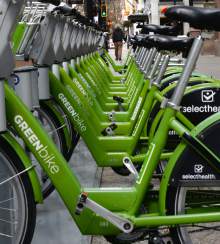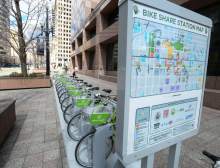This is an archived article that was published on sltrib.com in 2016, and information in the article may be outdated. It is provided only for personal research purposes and may not be reprinted.
GREENbike, Salt Lake City's non-profit bike-share program, is up and rolling — the earliest start in its four-year history.
Residents and visitors can check out 200 bikes at any one of 24 stations and return them to any station, making short trips downtown easy and efficient, according to director Ben Bolte.
He predicted GREENbike will continue to grow in 2016. Last year, 29,982 people bought 34,302 passes and rode over 106,000 times, he said. That represents a 292 percent increase over 2014.
A $5 pass allows riders unlimited 30-minute trips over a 24-hour period; A $15 pass provides unlimited 30-minute trips over four days; and a $75 pass gives riders unlimited 60-minute trips for the entire operating season, which was 266 days last year.
In addition, the program offers an office-pass program that allows groups to buy individual season passes for $25.
Not least, GREENbike also is good for Salt Lake City's air quality, Bolte said, adding the program reduced vehicle travel in Salt Lake City by 630,000 miles.
City Councilman Stan Penfold said the program is so popular that people are asking for more bikes and more stations.
"When you take that many people out of cars... and put them on bikes... it's impressive to see how much we can improve our air quality," Penfold said.
Mayor Jackie Biskupski said GREENbike also is creating an economic impact in the city with residents and visitors. "It allows them to spend money in various parts of the city," she said.
GREENbike also donates $1 to Make-A-Wish Utah every time a special blue bike is checked out. Last year, the blue Make-A-Wish bike was riden 860 times in 231 days — 60 percent more than the average GREENbike.
A breakdown of 2015 ridership reveals that Salt Lake City residents made up 36 percent of total trips; Salt Lake County residents took 14 percent; other Utahns comprised 19 percent; and out of state riders were responsible for 31 percent.







